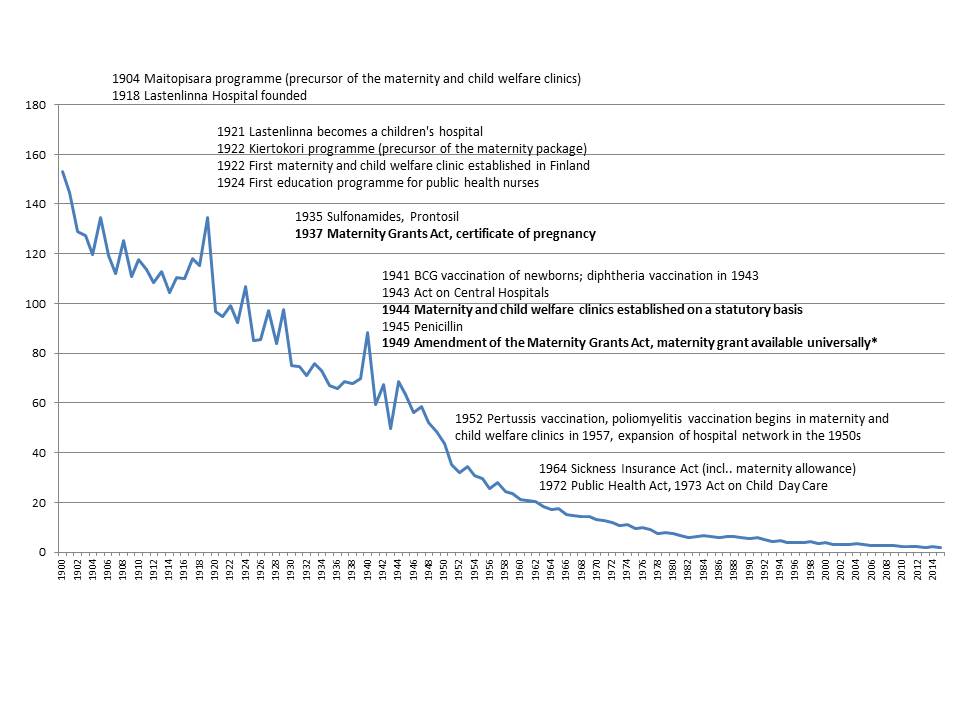The role of the Finnish maternity package in the promotion of public health
The significance of the maternity package for public health, including health promotion and the reduction of infant mortality, has generated much interest internationally.
After the enactment of the Maternity Grants Act in 1937, the first maternity grants were provided in the following year. They were initially intended for indigent mothers, and did not become universally available until 1949 (see details(Avautuu uuteen välilehteen)). The Maitopisara and Kiertokori programmes of the early 1900s can be seen as precursors of the maternity package and of maternity and child welfare clinics. They were established respectively to offer maternity counselling and to make child care items available to families on a loan basis (see Ahmala et al. 2014(Avautuu uuteen välilehteen)).
Because there is no empirical data, it is impossible to say unequivocally what the public health impact of the maternity package is. However, it is possible to explore this topic across time.
In the early 1900s, Finland was a poor agrarian society where social support was available mainly from family, church and the local poor relief system. Major public health challenges included the low standard of living and general hygiene, tuberculosis, epidemics, and a high rate of infant and child mortality.
The significance of the maternity package for the welfare and health of mothers and children can be analysed against the background of the general trends in public health during the 1900s. Important public health milestones include the establishment of maternity and child welfare clinics, the expansion of the health care system and the hospital network, the launching of vaccination programmes and the introduction of antibiotics, increases in the standard of living and the level of education, and the improvement of general hygiene.
Development of infant mortality from the early 1900s to the present
Figure 1 shows the development of infant mortality rate (number of infant deaths per 1,000 live births) in the period 1900-2015 and highlights some key factors in the welfare and health of mothers and children.
Infant mortality declined significantly in the early 1900s even before the introduction of the maternity grant. One important event for the health of expecting mothers and small children was the establishment of maternity and child welfare clinics in the 1920s, a development in which Arvo Ylppö played a decisive role. (He also made an essential contribution to developing the care of preterm babies.) The maternity and child welfare clinics were established on a statutory basis in 1944.
Progress was made during the 1930s and 40s in the pharmaceutical treatment of life-threatening bacterial infections. Prontosil, a sulfonamide drug, was introduced in the mid-1930s, followed some ten years later by penicillin.
The BCG vaccination of newborn infants, which began in 1941, was a crucial step towards the eradication of tuberculosis. Anti-diphtheria vaccination began a few years later in 1943, and during the 1950s, the vaccination programme expanded to cover also pertussis and poliomyelitis. The hospital network grew rapidly during the 1950s.
On the legislative front, 1964 saw the introduction of the Sickness Insurance Act, while the Public Health Act became law in 1972.
”Integrating the maternity grant scheme into the overallhealth care system and requiring recipients to undergo amedical examination have been essential to ensuring thehealth impact of the maternity package.”
Integrating the maternity grant scheme into the overall health care system and requiring recipients to undergo a medical examination have been essential to ensuring the health impact of the maternity package. Under the Maternity Grants Act of 1937, mothers were required to obtain a certificate from a physician or midwife after seven months of pregnancy.
Since 1949, the maternity grant has been available to all mothers living in Finland regardless of their financial circumstances. Mothers who wished to qualify tor the maternity grant were expected to see a doctor, midwife or the municipal maternity welfare clinic before the end of the fourth month of pregnancy (see Särkelä 2013(Avautuu uuteen välilehteen); Ahmala et al. 2014(Avautuu uuteen välilehteen)).
The maternity package has been an important factor in improving maternal and child health and has helped families in tangible ways, for example providing them with baby clothes and bedlinen. In the early decades of the 20th century, the poorest families were not necessarily able to provide a newborn with a clean place to sleep, and during wartime, textiles were in short supply.
The maternity package has been a part of overall public health efforts, motivated partly by the desire to boost the rate of population growth (see Särkelä 2013; Ahmala et al. 2014; Kela Slideshare(Avautuu uuteen välilehteen)). Yet the improvements seen in the health and well-being of expecting mothers and of babies are attributable also to other factors, ranging from the rise in living standards and educational levels to progress achieved in health and social provision as well as in family policy.
Rate of infant mortality
 Figure 1. Rate of infant mortality per 1,000 live births, 1900–2015.
Figure 1. Rate of infant mortality per 1,000 live births, 1900–2015.
* In order to qualify for the maternity grant, expecting mothers had to visit a doctor, midwife or the municipal maternity welfare clinic before the end of the fourth month of pregnancy.
Karoliina Koskenvuo
Head of Research Team, Senior Lecturer in Public Health
Kela (Social Insurance Institution of Finland)
firstname.lastname@kela.fi